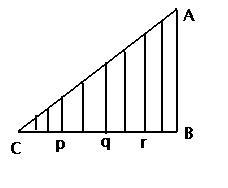D DIRECTION OF D FIELD AT D THREE POINTS ARE PARALLEL...........
so option (iii)Ep=Eq=Er ....
is dat d correct reason???????
There are infinite equipotential lines all parallel to the line AB in a right angled triangular region ABC as shown.All points on the vertical line have the same potential and proportional to the length of the line.

(a)An electron kept at rest will move parallel to the vector
(i) CB (ii)BA (iii)CA (iv)will remain at rest
(b)If Ep Eq and Er denote the electric field at P,Q,R respectively then
Ep>Eq>Er (ii)Ep<Eq<Er (iii)Ep=Eq=Er (iv)none
D DIRECTION OF D FIELD AT D THREE POINTS ARE PARALLEL...........
so option (iii)Ep=Eq=Er ....
is dat d correct reason???????
I MEAN D LENGTH FRM DOWNWARDS(BC) IS SAME WHERE p.q.r LIE........
There is some confusion with the question (sorry if im adding more )
its been given that points on horizontal line are also equipotential
and it says points on vertical line are also equipotential :)
P Q R are not on any horizontal line,here is a better pic fr the qsn

@ SUBASH.... U R RIT. IN QUESTION IT HAS BEEN GIVEN DAT HORIZONTAL LINES ARE EQUIPOTENTIAL N D POINTS IN VERTICAL LINE ARE AT SAME POTENTIAL.
BOTH IMPLIES D SAME.
There are infinite equipotential lines all parallel to the line BC in a right angled triangular region ABC as shown..........
BUT WHERE IS D LINE BC HERE?????????????
U CAN SEE D DIRECTION OF D FIELD AT D THREE POINTS ARE PARALLEL...........
phew.. so after 30 posts and a lot of discussion we are back to the original question..
so now what is the answer!
BUT BYAH.. THESE POINTS LIE IN DIFFERENT VERTICAL LINES BUT D POINTS ARE AT SAME POSITION IN HORIZONTAL LINE INTERSECTING THE VERTICLE LINE........
CLD U GET ME????????
and for
d first one
i m confused betwn CB and will remain at rest
bt odds in favor of CB is 3/5 :P :P
2nd answer is C
and for the reason since the equipotential surfaces are equidistant
the field is equal
for 1 the answer is CA
because A is at the highest potential
C is at the lowest potential
so electron moves parallel to CA
for 2nd one answer shd be Ep=Eq=Er coz itz an equipotential surface
For the first question the answer is AB
For the second it is option (c)
but the source isn't too reliable which is why i had to post the question here.
i think .............................................
that
p,q,r are on the vertical line
why r u making unnecessry doubts???
the answers given are different,but even i got the first answer same as you
for the 2nd 1,electric field is in the -ve direction of potential gradient,isnt it?
so Ep>Eq>Er, but the answer given is Ep=Eq=Er
All points on the vertical line have the same potential and "proportional to the length of the line"
@Mr Sparkle
for the 2nd 1
E =-dV/dr
so
asit is equipotential surfaces so ΔV =0 and hence C
@ sparkle .... can u explain y they r not at same potential???????
There are infinite equipotential lines all parallel to the line BC in a right angled triangular region ABC as shown.All points on the vertical line have the same potential and proportional to the length of the line.
do i need to say something more????
it is given ! read the question again
All points on the "vertical line" have the same potential and "proportional to the length of the line"